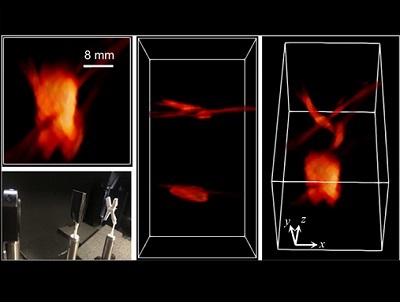
Reconstructed 3D images rendered in different perspective for the letter “X.” Credit: Intelligent Optics Laboratory, Liang Gao/UCLA Samueli
Key Points:
- Researchers developed CLIP, a new framework that allows the camera system to “see” with an extended depth range and around objects.
- CLIP was inspired by bats’ echolocation abilities, as well as insects’ geometric-shaped compound eyes.
- The technology could be incorporated into autonomous vehicles and medical imaging tools.
Inspired by flies and bats, engineers at UCLA have developed a new class of bionic 3D camera systems with multidimensional imaging and depth range that can scan through blind spots.
Powered by computational image processing, the camera can decipher the size and shape of objects hidden around corners or behind other items. Once perfected, the technology would be applicable in autonomous vehicles or medical imaging tools with sensing capabilities.
The researchers took cues from bats, who use echolocation to visualize their surroundings in the dark, as well as insects, who boast geometric-shaped compound eyes in which each “eye” comprises hundreds to tens of thousands of individual units for sight—making it possible to see the same thing from multiple lines of sight.
“While the idea itself has been tried, seeing across a range of distances and around occlusions has been a major hurdle,” said study leader Liang Gao, an associate professor of bioengineering at the UCLA Samueli School of Engineering. “To address that, we developed a novel computational imaging framework, which for the first time enables the acquisition of a wide and deep panoramic view with simple optics and a small array of sensors.”
Called “compact light-field photography,” or CLIP, the framework allows the camera system to see with an extended depth range and around objects. In experiments, the researchers demonstrated that their system can see hidden objects that are not spotted by conventional 3D cameras.
Gao and his team then combined CLIP with a type of LiDAR, or light detection and ranging. Conventional LiDAR, without CLIP, would take a high-resolution snapshot of the scene but miss hidden objects, much like our human eyes would. Using seven LiDAR cameras with CLIP, the array takes a lower-resolution image of the scene, processes what individual cameras see, then reconstructs the combined scene in high- resolution 3D imaging. The researchers demonstrated the camera system could image a complex 3D scene with several objects, all set at different distances.
According to Gao, CLIP helps the camera array make sense of what’s hidden in a similar manner. Combined with LiDAR, the system is able to achieve the bat echolocation effect so one can sense a hidden object by how long it takes for light to bounce back to the camera.
Information provided by UCLA School of Engineering.